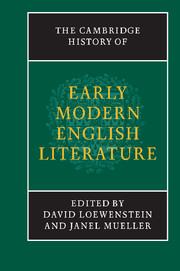Book contents
- Frontmatter
- Introduction
- 1 Modes and means of literary production, circulation and reception
- 2 The Tudor era from the Reformation to Elizabeth I
- 3 The era of Elizabeth and James VI
- 4 The earlier Stuart era
- 5 The Civil War and Commonwealth era
- 21 Literature and national identity
- 22 Literature and religion
- 23 Literature and London
- 24 Literature and the household
- 25 Alternative sites for literature
- 26 From Revolution to Restoration in English literary culture
- Chronological outline of historical events and texts in Britain, 1528–1674, with list of selected manuscripts
- Select bibliography (primary and secondary sources)
- Index
- References
24 - Literature and the household
from 5 - The Civil War and Commonwealth era
Published online by Cambridge University Press: 28 March 2008
- Frontmatter
- Introduction
- 1 Modes and means of literary production, circulation and reception
- 2 The Tudor era from the Reformation to Elizabeth I
- 3 The era of Elizabeth and James VI
- 4 The earlier Stuart era
- 5 The Civil War and Commonwealth era
- 21 Literature and national identity
- 22 Literature and religion
- 23 Literature and London
- 24 Literature and the household
- 25 Alternative sites for literature
- 26 From Revolution to Restoration in English literary culture
- Chronological outline of historical events and texts in Britain, 1528–1674, with list of selected manuscripts
- Select bibliography (primary and secondary sources)
- Index
- References
Summary
The middle decades of the seventeenth century in England were momentous in political, religious and material terms – with the country in the throes of political crises, religious sectarianism, and civil as well as foreign warfare – but they also represent a significant turning point in the history of English literary activity. The structures of patronage which had sustained and framed the literary output of previous generations (as discussed by Graham Parry in Chapter 4) were by now severely weakened and in some cases totally demolished. The court, the focal point of national culture (for good or ill) in the days of Elizabeth I and James I, had become the polarising, unfixed and shadowy entourage of Charles I at war, and after 1649 it moved into exile abroad. The English Church, instigator and inspiration of so much literary production since the Reformation, was divided, fragmented and ultimately disestablished until 1660. The public theatres, the material and financial context for a substantial amount of early modern writing, were closed between 1642 and 1660. Although some of the kinds of writing previously fostered by these three major institutions (for example, the lyric) continued to be produced, and although some of the issues that they had formerly expressed – love, religious devotion, power – continued to drive the texts of the mid-century, these new writings began to reveal the environment from which they predominantly came: the household.
- Type
- Chapter
- Information
- The Cambridge History of Early Modern English Literature , pp. 737 - 762Publisher: Cambridge University PressPrint publication year: 2003

